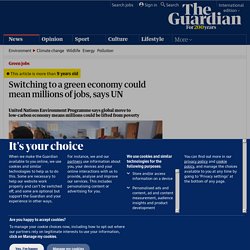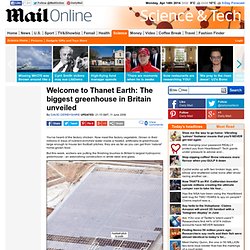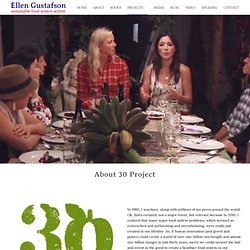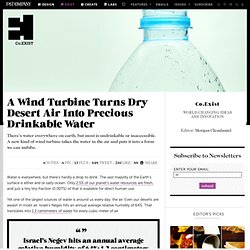

Www.calu.bangor.ac.uk/infosheets/EPC Horticulture Final Report FULL.pdf. ACT Publishing. Www.defra.gov.uk/statistics/files/defra-stats-foodfarm-landuselivestock-june-statsrelease-englandcropslivestocklabour-111024.pdf. Switching to a green economy could mean millions of jobs, says UN. Tens of millions of new jobs can be created around the world in the next two decades if green policies are put in place to switch the high-carbon economy to low-carbon, the UN has said.

Between 15m and 60m additional jobs are likely, according to a new report from the United Nations Environment Programme (Unep). These are net gains in employment for the world economy, taking into account any job losses in high-carbon industries that fail to transform. Achim Steiner, executive director of Unep, said: "The findings underline that [the green economy] can include millions more people in terms of overcoming poverty and delivering improved livelihoods for this and future generations. Welcome to Thanet Earth: The biggest greenhouse in Britain unveiled. By David Derbyshire Updated: 21:15 GMT, 11 June 2008 You've heard of the factory chicken.

Now meet the factory vegetable. Grown in their millions in trays of nutrient-enriched water inside a heated, artificially-lit greenhouse large enough to house ten football pitches, they are as far as you can get from 'natural' home-grown food. But this week, workers are putting the finishing touches to Britain's largest hydroponic greenhouse - an astonishing construction in white steel and glass. Massive: 'Thanet Earth' will cover 91 hectares of land in Kent.
Annie Murphy Paul: What we learn before we're born. Mark Bittman on what's wrong with what we eat. Dean Ornish on the world's killer diet. Louise Fresco on feeding the whole world. Cary Fowler: One seed at a time, protecting the future of food. 30 Project. In 1980, I was born, along with millions of my peers around the world.

Ok, that’s certainly not a major event, but relevant because in 2010, I realized that many major food system problems, which seemed so entrenched and unflinching and overwhelming, were really just created in our lifetime. So, if human innovation (and greed and power) could create a world of over one billion overweight and almost one billion hungry in just thirty years, surely we could unravel the bad and invest in the good to create a healthier food system in our lifetime, too?
In pursuit of this goal, I decided that the first step was to get people to really understand the problem. Ellen Gustafson: Obesity + Hunger = 1 global food issue. Carolyn Steel: How food shapes our cities. Jamie Oliver's TED Prize wish: Teach every child about food. Beyond LEED Certification: The Importance Of Creating Living Buildings.
Jason McClennan is the CEO of the International Living Future Institute, the organization that runs the Living Building Challenge--a green building standard that goes far beyond LEED and perhaps every other performance standard for the built environment (the first Living Buildings were certified in 2010).

The recently revised standard consists of seven "petals"--or performance areas--for buildings: site, water, energy, health, materials, equity, and beauty. Within those performance areas are a number of imperatives, including healthy air, appropriate sourcing, urban agriculture, net zero water and energy, and social justice. I spoke to McLennan about the future of living buildings at the recent Living Future Unconference.
A Wind Turbine Turns Dry Desert Air Into Precious Drinkable Water. Water is everywhere, but there’s hardly a drop to drink.

The vast majority of the Earth’s surface is either arid or salty ocean. Only 2.5% of our planet’s water resources are fresh, and just a tiny tiny fraction (0.007%) of that is available for direct human use. Yet one of the largest sources of water is around us every day: the air. Even our deserts are awash in moist air. Israel’s Negev hits an annual average relative humidity of 64%. The problem, of course, is that it’s rarely moist enough to rain. Now a French company, Eole Water, has successfully tested a wind turbine as a source of fresh water and renewable energy. Energy Efficient Greenhouse. The Basque Institute for Agricultural Research and Development has created an air-conditioned greenhouse which uses alternative energies to reduce the costs of energy while also improving the energy efficiency and increasing crop yields.
The greenhouse uses a biomass boiler and thermodynamic solar panels to reach an optimum temperature for crop growth without using fuels derived from petroleum oil or gas. The boiler uses wood and other organic waste as fuel, along with thermodynamic panels to air condition the greenhouses used for intensive crop cultivation. By doing this, the Basque Institute has managed to reduce the costs while producing seasonal crops to be harvested throughout the year. The Institute seeks to find an alternative to the usual diesel or heating oil boilers, which emit a high amount of CO2 into the atmosphere and are costly to the farmer due to the high price of petroleum oil-derived fuels.